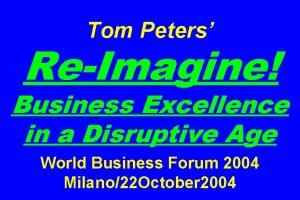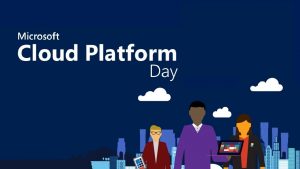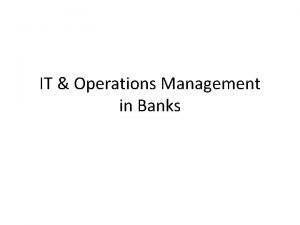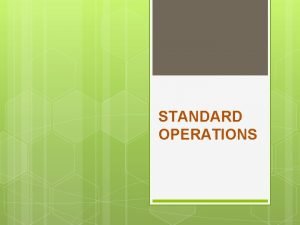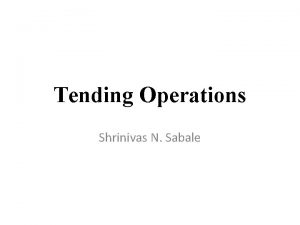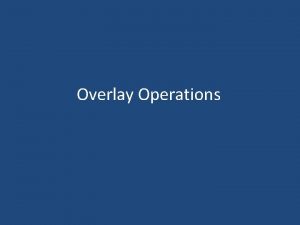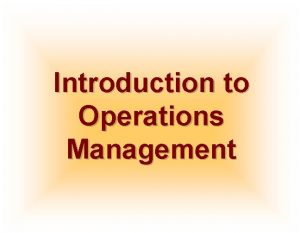Reimagine IT Operations for a CloudFirst World You












- Slides: 12

Reimagine IT Operations for a Cloud-First World You can’t afford to ignore the fast-changing infrastructure landscape. Info-Tech Research Group Inc. is a global leader in providing IT research and advice. Info-Tech’s products and services combine actionable insight and relevant advice with Info-Tech's products and services combine actionable insight advice ready-to-use tools and templates that cover theand fullrelevant spectrum of IT with concerns. and templates that cover the full spectrum of©IT 1997 -2019 concerns. © 1997 -2019 Info-Tech Research Group Inc. Info-Tech Research Group 1

ANALYST PERSPECTIVE The cloud is here. Turn on your fog lights: Cloud computing has fundamentally changed the game for organizations of all kinds, offloading previously time-consuming and complex tasks like server and storage provisioning to the automation delivered by cloud platforms. That does not mean cloud is without complexity – and cloud doesn’t mean No. Ops! When there’s a rush to deliver new functionality, operations can end up saddled with support for a dizzying host of different vendors, technologies, and support and cost models, held together with duct tape and bubblegum. At its core, cloud services remain infrastructure services. Most core operational processes remain, though related tasks and activities may be done differently than before. Identify high-priority operational activities and the roles, tools, and skills required to support those activities. Then, decide if making changes to the operations team can help you deliver key operational capabilities. Andrew Sharp Senior Research Analyst, Infrastructure & Operations Practice Info-Tech Research Group SAMPLE Info-Tech Research Group 2

Build an effective, cloud-ready IT operations team This Research Is Designed For: This Research Will Help You: • IT Infrastructure & Operations managers • Define the mission of the IT operations team, who want to build a team that’s empowered to deliver stable, serviceable, and efficient cloud services. • CIOs and CTOs who plan to lead their organization through a major cloud transition. • Other IT managers who want to clarify operational roles and responsibilities. • Operations teams who want to effectively support cloud infrastructure. • HR professionals supporting IT operations teams through organizational change. SAMPLE based on IT strategy and key cloud initiatives. • Clarify operational roles and responsibilities. • Understand the four key operational challenges in cloud services. • Identify maturity gaps in key operational activities, and assess organizational readiness to operate cloud services. • Prioritize action items and projects to improve the maturity of key operational activities. • Create a sketch of the future state operations organization, and identify any needed changes to responsibilities, roles, and/or resourcing. Info-Tech Research Group 3

Executive summary Situation • The business plans to increase its use of cloud services. • Both the business and IT are buying cloud services, but Operations isn’t • involved until the services break. Operational activities aren’t clearly defined or assigned, and things slip through the cracks. Complication • There is no unifying vision to meet cloud-related operational challenges. • The adoption of cloud hasn’t necessarily led to a deprecation of current, • • on-premises services, which may require integration with cloud services. Operations staff are unsure of their role in your organization in a cloudfirst world. Cloud abstracts away many day-to-day operational tasks. New skills are in short supply and training budgets are limited. 1. Cloud isn’t No. Ops! Well-implemented cloud infrastructure reduces tedious, repetitive tasks and gives Ops teams time to take a greater role in planning, management, and governance. 2. Form follows function. Structure your operations team to effectively deliver important capabilities that support organizational goals. 3. There’s more than one way to change. Find the type, pace, and scope of change that works for your organization. Resolution • • • Define the role of Operations in the IT organization, and how Operations will support key cloud initiatives. Create a high-level design sketch of the future-state operations team. Identify high-importance, low-maturity activities that must be improved to adequately support the new environment. Consider whether any activities should be insourced, outsourced, or co-sourced. Identify action items and projects that support the transition to the future state design. Clearly communicate the rationale for any major changes. SAMPLE Info-Tech Research Group 4

Re-imagine IT operations for a cloud-first world Operations should be involved in designing and building a stable, cost-effective, and secure production environment that delivers value to end users. This is a significant change. Why is it necessary? Cloud services provide abstraction that can reduce operational toil and provide an opening for operations teams to take on more responsibilities in build, planning, and design activities. Earlier and better contribution from the teams tasked with running new projects in production speeds up the deployment process, decreases the number and severity of bugs, and contributes to a production environment that is easier to manage and service. Current trends in operations management, including Dev. Ops and Site Reliability Engineering, emphasize a significantly expanded role and authority for the operations team in designing and building operable services. SAMPLE Design, Plan & Build Greater integration and collaboration Operate & Run Info-Tech Research Group 5

Do this project if your organization is facing these challenges This methodology is designed to support small and mid-sized IT operations teams as they redesign themselves to meet the challenges of managing cloud technologies. q Cloud strategy is front-and-center. It’s unclear how cloud will change the operations team’s responsibilities. q Operational responsibilities are unclear, leading to work duplication, missed work, delays, role conflict, inefficiencies, and/or a lack of accountability. q Team roles and reporting structures don’t line up with the work any more. q You need to add new operational capabilities to support a changed or changing IT operational model. q Operations staff are being asked to do work that’s not part of their job. q The larger IT organization has recently gone through major structural changes. q You’ve never actively planned the structure of the Ops team. It just happened over time. q You’re ready to make a transformational change to the structure of the operations team. SAMPLE Info-Tech Research Group 6

Take a structured approach to changing team design 60% How can managers succeed against the odds? of companies reported starting a restructuring project between 2013 and 2015. 1 Establish a clear rationale for change. Don’t try to force-fit the latest trends. Establish the drivers within your own organization that demand IT Operations change its ways. 2 Change the structure both in practice and principle. It’s not enough to change reporting relationships. Keep changes practical and reinforced with long-term investments in process, technology, and cultural change. 3 Look both within and beyond operations. Assess where stakeholders outside of operations could be affected by restructuring. Strategically involve impacted parties to manage and incorporate diverse and possibly conflicting opinions. But 77% of these projects failed. 1 in 3 failed to meet objectives or improve performance. 44% ran out of steam. Source: Aronowitz et al. , 2015 SAMPLE Info-Tech Research Group 7

An organization design methodology built on best practices The methodology in this blueprint synthesizes insights from experts and consultants around the industry into a process you can follow with your team. Industry approach In this blueprint, you will: Start with the organization’s long-term, strategic aspirations. Don’t let the past get in the way of future state planning. 2, 3, 5 Start by developing a vision statement for operations that supports key cloud initiatives and IT and business strategies. Restructuring should be the last step, not the first. 3, 4, 5 Establish the rationale for change, review processes, roles, and accountabilities, and create a sketch of the planned future state org. structure. Go beyond the boxes and lines in your organizational chart. 1, 2, 3, 4, 5 Review roles, activities, and processes. Consider culture, motivators, and incentives. Empower talented staff and managers to collaborate and make good decisions. 1, 2, 3, 4 Collaborate on design exercises. Identify delegated accountability for key activities. Identify critical success factors for short- and longterm objectives. Proactively identify interventions to address delays and obstacles. Set clear goals for the redesign. Track progress toward goals, and adapt the plan to meet those goals as required. 1, 2, 3, 4 1 Morieux, 2013. SAMPLE 2 Aronowitz et al. , 2015. 3 Neilson et al. , 2015. 4 Mc. Chrystal, 2015. 5 The Center for Organizational Design, 2015 Info-Tech Research Group 8

Assess the type of change that’s right for your organization Cut through the hype and decide how best to design your team to support organizational goals. • Get to consensus on cloud core concepts and service and delivery models. • Outline key drivers for the project: IT and business strategy and key cloud initiatives. • Assess where Operations fits in the IT department of the future and draft an end-state organizational sketch. PHASE 1 Strategy & Goals Direct Support New Initiatives & Projects Require Support New Operations Capabilities & Activities Modify Support Roles, responsibilities, team design SAMPLE Info-Tech Research Group 9

There are four operational challenges in the cloud PHASE 1 Identify the key activities that will help you manage cloud operational challenges. • Stable, cost-effective, and secure infrastructure is always the goal of operations management, but the activities and techniques to achieve those goals are dramatically evolving. • Prioritize the activities that will help you deliver the vision for your operations team. • Conduct a maturity assessment to assess current and target/future state maturity. Outline a plan to increase the maturity of critical activities. • Assign activities through a RACI matrix. It’s not important to increase maturity across all activities right away. Use the business strategy and cloud strategy to prioritize your efforts. SAMPLE Info-Tech Research Group 10

PHASE 2 Build an effective, cloud-ready operations team Validate your direction using data from the Activities Assessment. • Ensure accountability and decision-making authority is appropriately aligned and that high-priority improvement initiatives are properly resourced. • Identify needed skills, knowledge, and tools, and build a training plan. • Consider span of control, and decide if span of control requires adjustment. • Conduct a final assessment on the design outputs. Once you’ve completed this project, work with HR to identify: • Which staff and managers will move to which roles, and any headcount changes. • Job descriptions, performance metrics, career paths, compensation, succession planning. • Organizational change management, and implementation plans. SAMPLE Info-Tech Research Group 11

Dive Deeper Into Our Research by Clicking One of the Elements Below Find out how Info-Tech makes your job easier. SAMPLE Contact Us Today: Toll-Free (US & Canada): 1 -888 -670 -8889 Info-Tech Research Group 12
